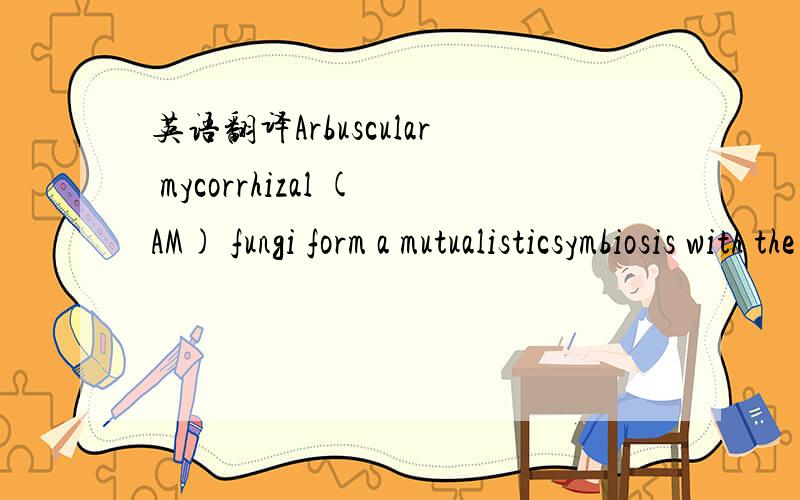英语翻译Arbuscular mycorrhizal (AM) fungi form a mutualisticsymbiosis with the roots of most land plants.They confer anutritional benefit to their hosts by taking up phosphorus (P)and other macronutrients,trace elements and water from thesoil and
来源:学生作业帮助网 编辑:作业帮 时间:2024/04/29 07:25:58

英语翻译Arbuscular mycorrhizal (AM) fungi form a mutualisticsymbiosis with the roots of most land plants.They confer anutritional benefit to their hosts by taking up phosphorus (P)and other macronutrients,trace elements and water from thesoil and
英语翻译
Arbuscular mycorrhizal (AM) fungi form a mutualistic
symbiosis with the roots of most land plants.They confer a
nutritional benefit to their hosts by taking up phosphorus (P)
and other macronutrients,trace elements and water from the
soil and transferring them to their host plants.Most attention
has been focused on P acquistion (Smith
et al
.,1994; Harrison& Van Buuren,1995; Smith & Read,1997; Rausch
et al
.,
2001; Ezawa
et al
.,2002)
.
However nitrogen (N) is also an
important element whose uptake from nutrient poor soils
to roots can be improved by AM fungal colonization (Ames
et al
.,1983; Jennings,1995; Johansen
et al
.,1996; Smith &
Read,1997).
The extraradical hyphae of (AM) fungi are able to take up
and assimilate ammonium (NH
4
+
) (Ames
et al
.,1983; George
et al
.,1992; Johansen
et al
.,1992,1993,1996; Frey & Schüpp,
1993),nitrate (NO
3
–
) (Tobar
et al
.,1994; Bago
et al
.,1996;
Johansen
et al
.,1996) and amino acids (AAs; Hawkins
et al.
2000; Hodge
et al
.,2001) from their surroundings andtranslocate N from diverse sources to the plant (Hawkins
et al
.,2000; Azcón
et al
.,2001; Vazquez
et al
.,2001).AM
fungi can apparently also transfer N from one plant to
another (Bethlenfalvay
et al
.,1991; He
et al
.,2003; Cheng &
Baumgartner,2004) and can increase the availability of different
forms of N to plants (Hodge
et al
.,2001).However,
when and where fungal transport of N plays an important
part in plant nutrition remains unclear (Smith & Read,1997;
He
et al
.,2003).
Assimilation of NH
4
+
is a principal means of N absorption
both in ectomycorrhizal (Martin
et al
.,1986; Finlay
et al
.,1989;
Chalot
et al
.,1991; Martin & Botton,1993) and AM fungal
systems (Bago
et al
.,1996; Hawkins
et al
.,2000; Toussaint
et al
.,2004).N uptake and incorporation into AAs via the
glutamine synthetase,glutamate synthase (GS/GOGAT)
cycle has been found in ectomycorrhizal fungi (Martin,1985;
Vèzina
et al
.,1989; Chalot
et al
.,1994).Smith
et al
.(1985)
also described the activity of the GS/GOGAT enzymes in
AM fungi.Also in an AM fungus,Govindarajulu
et al
.(2005)
found support for N assimilation in the extraradical mycelium
(ERM) via the GS/GOGAT pathway by measuring mRNA
levels for key enzymes in the ERM and intraradical mycelium
(IRM) tissues with quantitative real-time polymerase chain
reaction.They also demonstrated the expression of a putative
nicotinamide adenine dinucleotide (NAD)-dependent glutamate
dehydrogenase (GDH ) gene,which is down-regulated
in the ERM tissue supplied with either NO
3
–
or NH
4
+
in the
ERM compartment,consistent with this enzyme having a
catabolic role (Vallorani
et al
.,2002).The report by Breuninger
et al
英语翻译Arbuscular mycorrhizal (AM) fungi form a mutualisticsymbiosis with the roots of most land plants.They confer anutritional benefit to their hosts by taking up phosphorus (P)and other macronutrients,trace elements and water from thesoil and
丛枝菌根(AM)真菌形成互惠
共生与大多数陆地植物的根.他们赋予
营养利于他们的主机,采取了磷(P)
和其他大量元素,痕量元素和水从
土壤并将他们转移到他们的寄主植物.最受关注
都集中在P采集(史密斯
等
.,1994;哈里森&凡布伦,1995;史密斯和了解,1997年;劳施
等
.,
2001年;埃萨瓦
等
.,2002年)
.
但氮(N)也是一
重要元素,其吸收养分贫瘠从
以根可提高AM真菌定植(埃姆斯
等
.,1983;詹宁斯,1995年;约翰森
等
.,1996年;史密斯&
了解,1997年).
作者:(上午)真菌根外菌丝能够采取行动
和吸收铵(新罕布什尔州
4
+
)(埃姆斯
等
.,1983;乔治
等
.,1992;约翰森
等
.,1992年,1993年,1996年;弗雷和舒普,
1993年),硝酸盐(NO
3
-
)(托巴尔
等
.,1994;勃固
等
.,1996年;
约翰森
等
.,1996),法(AAS氨基酸;霍金斯
等人.
2000年霍奇
等
.,2001年)从他们来自不同来源的环境andtranslocate氮对植物(霍金斯
等
.,2000年; Azcón
等
.,2001年;巴斯克斯
等
.,2001).上午
真菌可以从一个显然也转移到植物N
另一个(Bethlenfalvay
等
.,1991;他
等
.,2003;郑和
鲍姆加特纳,2004年),可以增加不同的可用性
氮素形态对植物(霍奇
等
.,2001).然而,
何时何地的N真菌运输起着重要的
在植物的一部分营养仍不清楚(史密斯和了解,1997年;
他
等
.,2003).
同化的NH
4
+
是一种主要手段吸收的N
无论是外生菌根(马丁
等
.,1986;芬利
等
.,1989年;
Chalot
等
.,1991;马丁&波顿,1993年)以及AM真菌
系统(勃固
等
.,1996年;霍金斯
等
.,2000年;图森特
等
.,2004).校友会氮吸收并纳入经
谷氨酰胺合成酶,谷氨酸合成酶(GS /氨同化)
周期已发现外生菌根真菌(马丁,1985;
韦斯纳
等
.,1989年; Chalot
等
.,1994).史密斯
等
. (1985年)
还介绍了的GS /氨同化酶的活性
AM真菌.另外,在一上午真菌,Govindarajulu
等
. (2005年)
发现支持N的根外菌丝吸收
(风险管理)通过的GS /氨同化途径,通过测量基因
在企业风险管理水平和intraradical菌丝关键酶
(IRM)的定量实时聚合酶链组织
反应.他们还展示了一个公认的表达
烟酰胺腺嘌呤二核苷酸(NAD)的依赖性谷氨酸
脱氢酶(GDH)基因,它是下调
在与企业风险管理组织或者没有提供
3
-
或NH
4
+
在
企业风险管理室,与此有一个一致的酶
分解代谢的作用(瓦洛拉尼
等
.,2002).该报告由Breuninger
等